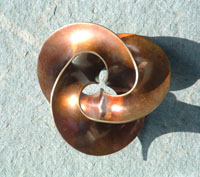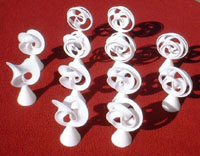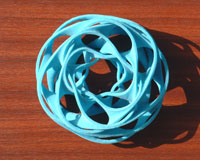Sculpture Models for the Touring Art Exhibit:
"Art-Math / Math-Art", Ringling School of Design, 2005
Below are the descriptions of the Scherk-Collins Toroids designed
on Carlo
H. Séquin's sculpture generator.
 "Minimal Saddle Trefoil"
(1997)
"Minimal Saddle Trefoil"
(1997)
Designed by Carlo Séquin with the goal to find the tightest configuration
by which a chain of 3 saddles could be closed into a toroidal ring.
Specifications: 3 stories, 2nd-order saddles, 270 degrees twist.
Realization: 6" diameter, Stereolithography master by Metalcast Engineering;
from which via a 5-part mold a bronze sculpture was cast by Steve Reinmuth.
 "Trefoil Family"
(2000)
"Trefoil Family"
(2000)
Collection of 12 models that exhibit 3-fold as well as front-to-back symmetry.
Variations occur in the branching degree of the saddles (ranging from B=1 to B=4)
and in the azimuth orientation of the flanges (the 2 values that yield front-to-back symmetry)
and in the number of times that the saddle-chain winds around the central hole (either W=1 or W=2).
Realization: 3" diameter, Fused Deposition Modeling (FDM), Stratasys Corporation, San Jose, CA.
 "Woven Quad"
(1999)
"Woven Quad"
(1999)
A more elaborate Scherk-Collins Toroid in which the hole-saddle-chain winds twice
around the toroidal loop, interlocking with itself without any self intersection.
Specifications: 9 stories, 4th-order saddles, 45 degrees twist.
Realization: 7.5" diameter, 3D-Print; courtesy Z Corporation, Burlington, MA.
Scherk-Collins Trefoils and More Complex Toroids
These pieces illustrate the collaboration between Carlo
Séquin and Brent Collins and introduce the notion of a “sculpture family”
generated from one set of parameterized shapes. The core shape is the “Minimal
Trefoil,” a Scherk-Collins toroid with only three stories of saddles and holes.
In our search for such a ring with a minimal number of stories, Brent Collins
and I came up with topologically equivalent, but geometrically rather different
looking shapes (compare Séquin’s 6inch trefoil cast in bronze and Collins’
large wooden trefoil). However, both our solutions exhibited 3-fold rotational
symmetry and 270 degrees of twist.
In the “Trefoil Family” on display, all forms were generated
with Séquin’s “Sculpture Generator I” by varying only a few parameters.
All twelve models have three stories and exhibit 3-fold as well as front-to-back
symmetry. The variations occur in the branching degree of the saddles (ranging
from B=1 to B=4), in the azimuth orientation of the flanges (values of A that
yield front-to-back symmetry), and in the number of times that the saddle-chain
winds around the central hole (either W=1 or W=2). Of the 16 possible
combinations, the 12 most pleasing ones have been selected and fabricated on a
Fused Deposition Modeling machine.
Finally, the “Woven Quad” demonstrates that
the hole-saddle-chain can also be wound twice around the toroidal loop,
forming a much more elaborate Scherk-Collins Toroid. The interactive nature of the
“Sculpture Generator I” allowed easy adjustment of the flange parameters
to generate this interlocking configuration without any self intersection, provided
that an odd number of stories is chosen. In this model there are nine 4th-order saddles,
Artist’s Statement, Carlo H.
Séquin
Since high school I have been fascinated by geometry. I
enjoyed constructing the more complicated Platonic solids with ruler and
compasses, as well as reading about the 4th dimension. I went on to study
physics at the University of Basel, and in 1970 started working at Bell
Telephone Laboratories on the design of Charge-Coupled Imaging Devices. There,
in Murray Hill, I was introduced to the field of Computer Graphics in courses
given by Ken Knowlton and Lillian Schwartz.
In 1977, I joined the faculty of the Computer Science
Division at the University of California, Berkeley. Inspired by a talk by
artist Frank Smullin, I started to develop the Berkeley UniGrafix rendering
system, so that I could depict objects such as the "Skeleton of a Klein
Bottle" or the "Granny-Knot Lattice." Since then, the focus of
my work has been on computer-aided design (CAD). First I developed programs to
support circuit designers, later architects and mechanical engineers, and
recently even artists.
In 1995 I started a close collaboration with Brent Collins,
who had been sculpting abstract geometric art for two decades. With my
students, I developed a procedural “Sculpture Generator” program, to help
Collins prototype potential future work in virtual form. Later programs
generalized the original concepts, and eventually expanded the design space
through new paradigms. In this work I see myself as a composer in the realm of
pure geometry. The artistic achievement lies in finding a procedural formulation
that can reflect the inherent symmetries and constructive elegance that seems
to lie beneath the physical laws of our universe.
Page Editor: Carlo H. Séquin
